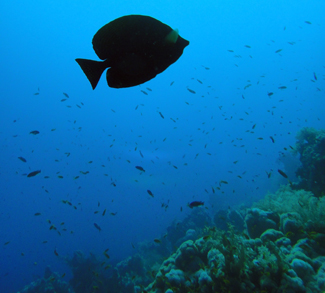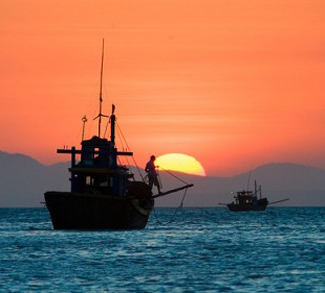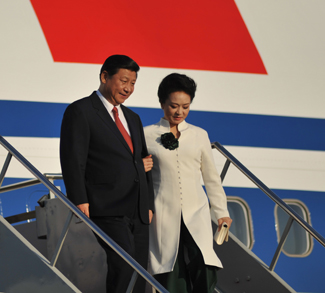Protecting marine environments and ensuring the ocean’s sustainability is a global issue that is vital for all life, and nowhere is this more important than in the South China Sea.
Extending across tropical and semi-tropical zones, this body of water offers an abundant and complex marine ecosystem. However, the territorial claims among China, Vietnam, Taiwan, the Philippines, Malaysia, and Brunei in the South China Sea remain a serious threat to the political and ecological security of Southeast Asia. As such, environmental degradation remains at the center of South China Sea scientific policy conversations, and for an increasing number of policy shapers and scientists, there’s an urgent need to address acidification, biodiversity loss, regional impacts of climate change, coral reef destruction, and fishery collapses.
Enter science diplomacy. Defined by the American Association for the Advancement of Science (AAAS) as science being used to inform foreign policy decisions, promote international scientific collaborations, and establish scientific cooperation to ease tensions between nations, science diplomacy is a widely accepted method that environmental policy planners use to contribute to conflict resolutions and, for several decades, has been adopted as a diplomatic tool for peace-building by many countries. During the Cold War divide, scientific cooperation was used to build bridges of cooperation and trust.
Science diplomacy is not a completely new approach to international relations, and, at the moment, has raised two important questions in efforts to successfully settle the South China Sea dispute, namely: Should we do it? And will it work?
The answer to both is, “yes.”
Science initiatives are more widely accepted as efforts to solve global issues that require contributions from all players in the international relations arena.
Science diplomacy helps directly and indirectly promote confidence-building among the parties involved in the South China Sea dispute, offering a much-needed strategic pause in rising regional tensions. The probability that science diplomacy can successfully manage the South China Sea dispute is quite high because of timing, creditability, and the potential for support from major powers. It offers more advantages than not in terms of economics, politics, social responsibility, and beyond. Most importantly, there’s already a rising tide of cooperation in the exchange of data and information, consensus on the value of marine protected areas, and an increase in joint research expeditions.
There are strong ties among scientists across Southeast Asia and China, partly due to a series of international scientific projects, conferences, and training workshops, such as those associated with the United Nations Food and Agriculture Organization’s South China Sea Fisheries Development and Coordination Program from the mid 1970s to the mid-1980s. Informal “Track 2” working groups and associated fieldwork throughout the 1990s and up to the early 2000s included many regional scientists and their projects aimed at promoting peaceful joint resource management in the South China Sea. The UNEP and Global Environment Facility sponsored a South China Sea environmental analysis and management project from 2002 to 2009, and efforts are underway to initiate a follow up project. Other such confidence-building activities are under discussion.
These proposed science collaborative measures are essential in the face of the rampant overfishing and coral reef degradation that has occurred across the South China Sea, in part because the conflicting territorial claims have made ecological analyses and management actions difficult. There are strong indications of impending collapses of fisheries and potential species extinctions. Given the fact that the South China Sea hosts a large proportion of known marine species, including threatened giant clams, sea turtles, and marine mammals, there is no time to waste.
The prospect of a fisheries apocalypse in the South China Sea should weigh heavily on all claimant nations, all of which rely on fish protein to feed a burgeoning population of roughly 1.9 billion people. Challenges around food security and renewable fish resources are fast becoming a hardscrabble reality for more than fishermen. In 2014, the Center for Biological Diversity warned that it could be a scary future indeed, with as many as 30 to 50 percent of all species possibly headed towards extinction by mid-century.
Nevertheless, it’s encouraging that Chinese scientists have been engaged in science diplomacy in polar regimes for the past three years. This includes cooperative fishing regulations research and especially their participation multilateral diplomacy efforts in the central Arctic Ocean. Although Beijing’s role is still limited, they are preparing to play a substantial role in good governance in the Arctic.
Despite the intractable SCS sovereignty issues, and difficulties in securing permissions for environmental field work, even in non-disputed areas, a focus among regional scientists on environmental protection and fishery issues may prove far less difficult than problems in the Arctic.
Science diplomacy seems quite affordable for all claimant countries. In fact, while it is hard to draw an exact comparison of the expenditures a government provides for other ways of solving the South China Sea dispute, science diplomacy would prove very cost effective. Because military and economic initiatives, especially the transformation of reefs into military outposts, unlike scientific ones, are often seen as the actions of one country protecting its sovereignty and is directly related to national defense, any non-state actor’s involvements are inevitably sensitive subjects and considered inappropriate.
The key is to encourage international scientific cooperation. Through joint marine research surveys, the region’s scientists can provide policymakers with the data and information they need to make informed and responsible decisions in the South China Sea.
Science initiatives are more widely accepted as efforts to solve global issues that require contributions from all players in the international relations arena. This not only makes science diplomacy-related initiatives financially possible, but also leads to broader dissemination of results and enhances their impacts on policy decision-making and capacity-building on the regional level.
Most SCS states have adopted marine protected areas to address present and future environmental issues, and there are plans to include areas that fall within disputed waters. Existing MPAs play important roles in the development of the marine economy; they improve the livelihoods of coastal fishing communities and also serve as an excellent directed science policy model. If sovereignty concerns could be set aside in treaties implementing freezes on claims and claim-supportive activities, as has been done in the Antarctic, these and other natural resource management tools could be used far more effectively to secure fisheries and biodiversity, and also to promote sustainable tourism.
Secondly, science diplomacy is a safe and neutral approach to international relations for all governments. While economic or military cooperation requires strong consideration for signs of foreign policy direction, scientific cooperation is much more neutral, even in conflict-torn countries, since they can cooperate with each other in scientific projects “to affirm and to improve human life” without worrying about misleading the international community about their foreign policy orientation or invoking domestic anger because of shaking hands with the “wrong partners.”
Finally, science diplomacy serves essential needs in the lives of human beings. While other types of diplomacy tend to only solve issues at the state level, like sovereignty or territorial integrity, the science research cooperation in the South China Sea aims at a more “down-to-sea” approach, namely ensuring that fishers can fish safely, marine products for human beings are unpolluted, and marine resources are protected correctly.
Looking at science diplomacy from a broader perspective, it provides collateral benefits to resolving the South China Sea dispute. Last year, Fidel V. Ramos, the former president of the Philippines (1992-1998), and a member of the ASEAN Eminent Persons Group stated that environmental cooperation could promise to bring about “mutually beneficial efforts to improve tourism and encourage trade and investment, and to promote exchanges among think tanks and academic institutions on relevant issues.”
Science diplomacy offers a peace-building mechanism for South China Sea scientific advisors to demonstrate their roles as “resource analysts, trend spotters, science communicators, and applied-policy advisors.”
With natural resource politics steering the South China Sea narrative, science diplomacy offers the dual hope of protecting coral cathedrals, marine habitats, and fish species, and it can serve as a peace-building model for similar environmental conflicts elsewhere.
The opinions, beliefs, and viewpoints expressed by the authors are theirs alone and don’t reflect any official position of Geopoliticalmonitor.com.




